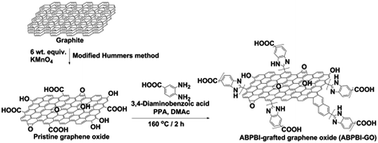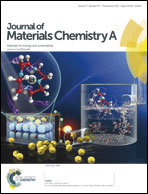Sulfonated poly(arylene ether sulfone) composite membranes having poly(2,5-benzimidazole)-grafted graphene oxide for fuel cell applications†
Abstract
Sulfonated poly(arylene ether sulfone) (SPAES) composite membranes were prepared using thermally-treated graphene oxide (GO) and poly(2,5-benzimidazole)-grafted graphene oxide (ABPBI-GO) as fillers for proton exchange membrane fuel cell (PEMFC) applications. Pristine graphene oxide was obtained from graphite by chemical oxidation, and 3,4-diaminobenzoic acid was then reacted with pristine graphene oxide to obtain ABPBI-GO. When GO and ABPBI-GO were incorporated into the SPAES matrix, the dimensional stability and mechanical strength of the membrane were improved. In particular, the SPAES/ABPBI-GO composite membranes exhibited improved dimensional stability, larger Young's modulus, and larger elongation at break than the SPAES/GO composite membranes due to the acid–base interaction between the sulfonic acid group of the SPAES matrix and the basic imidazole unit of ABPBI-GO. In addition, the SPAES/ABPBI-GO composite membranes possessed higher proton conductivity than pristine SPAES and SPAES/GO composite membranes because the acid–base interaction can generate additional proton conduction pathways in the membrane structures.


 Please wait while we load your content...
Please wait while we load your content...